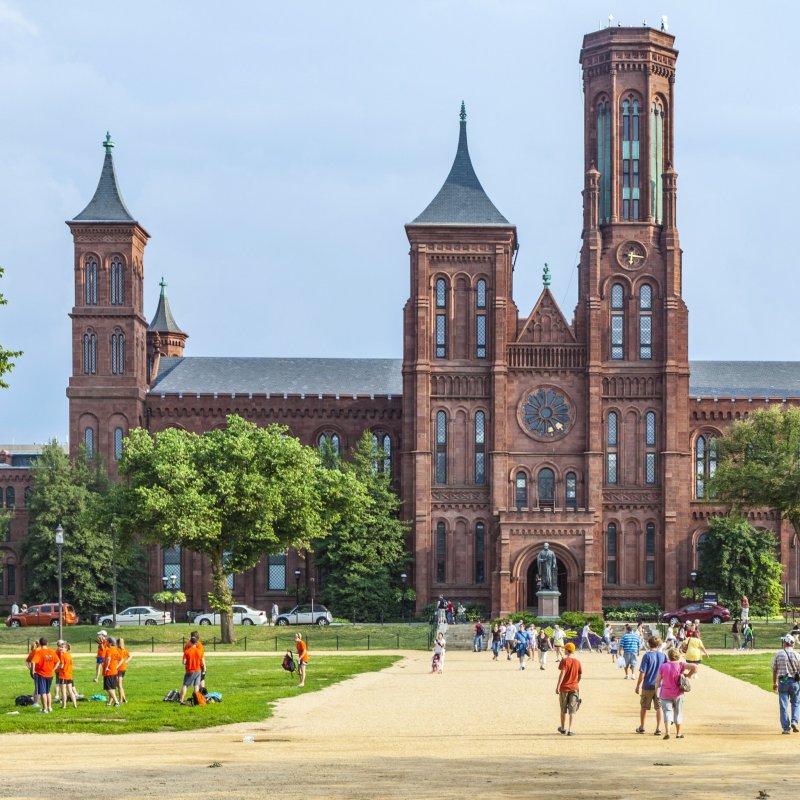
Washington, D.C., offers so much to see and do that incorporating a visit to the Smithsonian might seem overwhelming. After all, the Smithsonian isn’t a single museum. Rather, it’s a collection of 19 museums, galleries, gardens, and a zoo, making it the world’s largest museum complex.
Videos by TravelAwaits
How do you know which exhibits to focus on when you visit the capital city? If you’re a history lover, you can start with the following iconic exhibits.
Pro Tip: Nicknamed America’s Treasure Chest, the Smithsonian’s collections include more than 156 million artifacts and works of art. However, only a small percentage — about 2 percent — is on display at any given time. So be sure to visit the Smithsonian’s website before you go to ensure that the object you wish to see is on display (or to select an alternative from that era in history).
James Smithson’s Crypt
Smithsonian Institution Building (The Castle)
Begin your adventures at the Smithsonian with a stop at the Smithsonian Institution Building, also known as the Smithsonian Castle. Not only does the red sandstone building house the Smithsonian Visitor Center, but it is also the final resting place of James Smithson. An English chemist and lifelong learner who never married or had children, Smithson left his estate to a nation he never visited to form what would become the Smithsonian Institution.

Treaties Between The United States And American Indian Nations
National Museum Of The American Indian
For centuries before the first European set foot on North America, nearly 600 distinct Native American tribes called this land home. Over the years, as settlers usurped Native American lands and chipped away at their way of life, more than 370 treaties were ratified between Europeans and Native Americans.
This exhibit at the National Museum of the American Indian features a rotating display of eight treaties. To preserve the fragile documents for future generations, each treaty can only be displayed for about six months before being returned to the archives.
As you visit the museum, be sure to take note of the unique structure. Not only did a team of Native Americans design the five-story museum, but Native Americans also manage its daily operations. From the seasonal Native American-inspired menu in the museum’s cafe to the displays throughout the museum, the experience is quite different from those offered by museums of European and Euro-American culture.
Star-Spangled Banner (Great Garrison Flag)
National Museum Of American History
Chances are you’ve heard how the “broad stripes and bright stars” of the American flag raised above Fort McHenry during the War of 1812 inspired Francis Scott Key to pen our national anthem. But have you seen the original? On display at the National Museum of American History, the 15-star banner is missing at least eight feet of fabric due to deterioration and patriotic Americans who snipped pieces as keepsakes.
Declaration Of Sentiments Table
National Museum Of American History
The Declaration of Independence states that each of us possesses the right to life, liberty, and the pursuit of happiness. But the truth is that American women were treated as second-class citizens for many years. Fed up with the inequality, Elizabeth Cady Stanton and Lucretia Mott drafted a declaration of rights specifically for American women in 1848. And the table where the Declaration of Sentiments was signed is on display at the Smithsonian.

‘Fireside Chat’ Microphone
National Museum Of American History
Before social media, the Internet, and television shaped communication in America, there was radio. And it was through this “new” medium that President Franklin D. Roosevelt addressed the American public as he led the nation through some of its biggest challenges, including the Great Depression and World War II. The 32nd president used the NBC microphone on display at the Smithsonian to broadcast 30 “fireside chats” during his presidency.
Entrenching Tool From World War I
National Museum Of American History
The world’s first truly global conflict, World War I was known for trench warfare. Along the Western Front, young men dug long, narrow trenches between warring Germany and the Allied Powers of France, Belgium, and the Netherlands; there, they’d hunker down for weeks at a time. The entrenching tools used to dig miles of trenches were less than 2 feet long.
Charles Lindbergh’s Spirit Of St. Louis
National Air And Space Museum
When I think of the history of flight in America, the Wright brothers, Amelia Earhart, and Charles Lindbergh come to mind. In his silver, single-engine plane (named for the folks who financed the custom-built craft), legendary aviator Charles Lindbergh became the first person to fly nonstop from New York to Paris in 1927. Today, the trendsetting aircraft is prominently displayed in the Boeing Milestones of Flight Hall.

Mobile Quarantine Facility (MQF) From The Apollo 11 Landing
Steven F. Udvar-Hazy Center
About 40 minutes west of Washington, D.C., near Dulles International Airport, the 760,000-square-foot Steven F. Udvar-Hazy Center contains a variety of additional air-related artifacts beyond those at the National Air and Space Museum. And whether you witnessed the historic moon landing in real time on television or learned about it after the fact, you’ll likely recall the Apollo 11 astronauts peering out of the back of the MQF as they were welcomed home by President Richard Nixon.
Rosa Parks’s Dress
National Museum Of African American History And Culture (NMAAHC)
During her commute home in 1955, Rosa Parks was arrested for refusing to give up her bus seat to a white man. At the time of her arrest, the seamstress was stitching a long-sleeved, shawl-collar floral print dress that you can see at the NMAAHC.
Pro Tip: While there is no admission fee to visit any of the Smithsonian museums, galleries, or gardens, timed-entry tickets are currently required to visit the NMAAHC.
Apple Macintosh Personal Computer
National Museum Of American History
Launched via an Orwellian commercial that aired at the Super Bowl XVIII, the Apple Macintosh revolutionized personal computing by being the first home computer with a built-in screen and mouse. The Mac’s graphical user interface (GUI) allowed users to click, drag, and drop instead of typing out commands. Computers have advanced tremendously since the mid 1980s, so don’t miss this first-generation Apple computer when you visit the Smithsonian.

Julia Child’s Kitchen
National Museum Of American History
Whether you remember it from her television show, The French Chef, or from the end of the award-winning movie Julie & Julia, you won’t want to miss Julia Child’s kitchen at the National Museum of American History. Built with higher-than-standard countertops to accommodate the chef’s height, the kitchen was moved from Child’s home in Cambridge, Massachusetts, to the Smithsonian in 2001.
Portraits Of Barack And Michelle Obama
National Portrait Gallery
Although an official portrait of each president is hung in the National Portrait Gallery at the end of their term, President Barack Obama made history by being the first black American elected to the highest office. It was also the first time that a black artist was commissioned to paint an official presidential portrait.
While it’s in the 20th-Century Americans exhibit instead of the America’s Presidents gallery, First Lady Michelle Obama’s portrait by Amy Sherald is also a first — the first portrait of a First Lady painted by a black artist.

Tips For A Fantastic Visit To The Smithsonian
- The Smithsonian welcomes nearly 30 million visitors per year, so you’re likely to experience a crowd when you visit. Consider starting your tour on the top floor and working your way down.
- The Smithsonian is an inclusive attraction and provides detailed information about accessibility on its website.
- Whether you visit one exhibit, one museum, or multiple Smithsonian buildings, be prepared to do a lot of walking. In addition to wearing comfortable shoes, take a load off by relaxing in the Hirshhorn Museum’s sculpture garden or by watching a movie at the Air and Space Museum.
